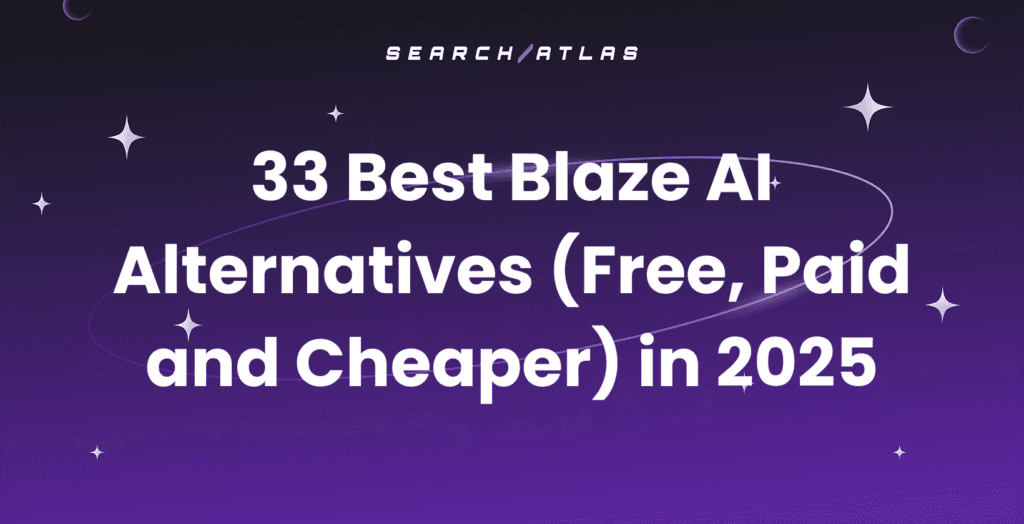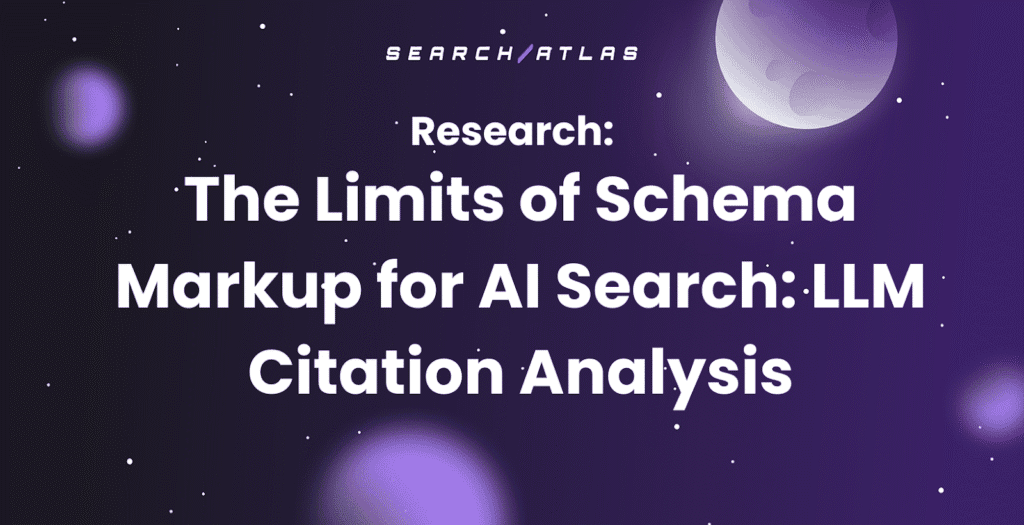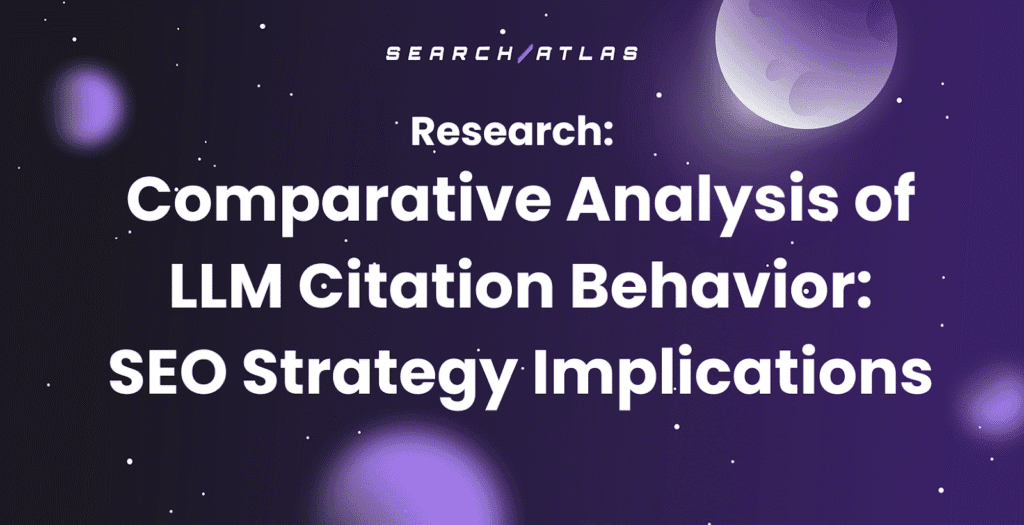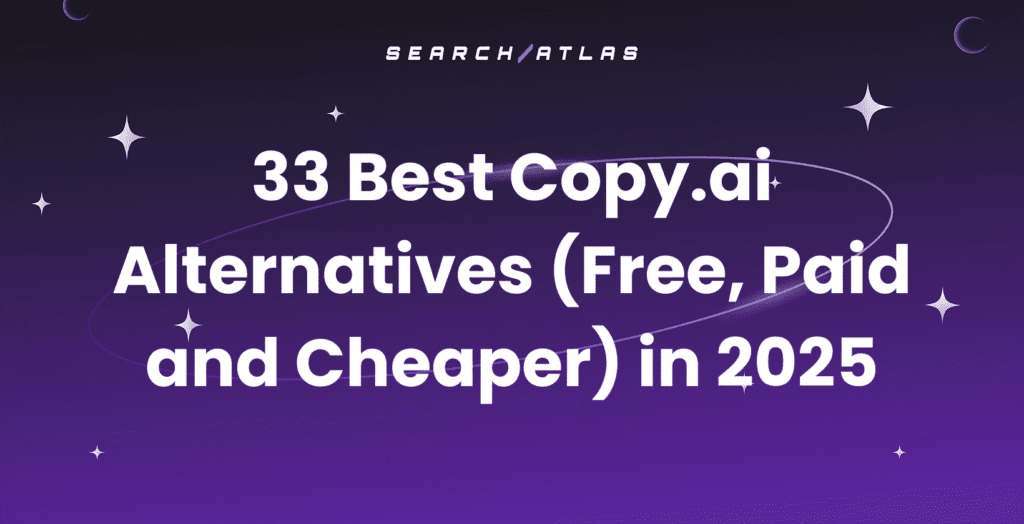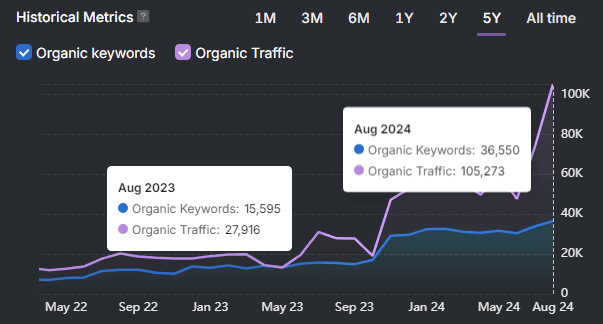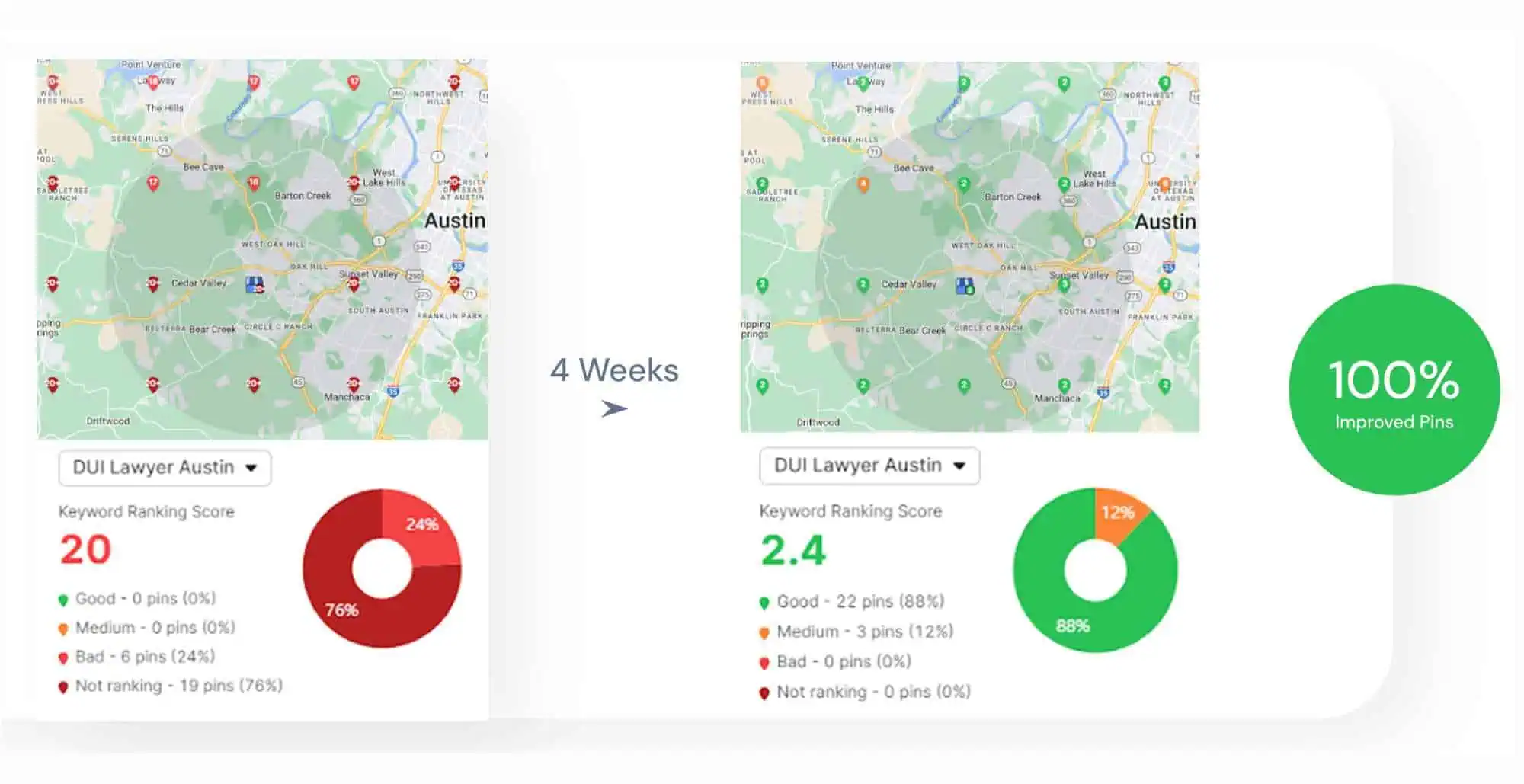An SEO strategy is a plan that outlines how a website will improve its visibility on search engines like Google. An SEO strategy involves identifying the most relevant keywords, optimizing website content and structure, improving technical performance, and building authority through backlinks. The importance of a search engine optimization strategy lies in its ability to make sure your website ranks higher in search results, attracts more qualified traffic, and ultimately supports your business goals.
To create an SEO marketing strategy, start by benchmarking your website’s current SEO performance and analyzing competitors’ SEO strategies to get a clear picture of where your website currently stands and where it can improve. Define your SEO goals and focus on understanding your target audience, including their search behavior, pain points, and intent. Improve and update your existing content, build topic clusters, and optimize both on-page SEO and technical SEO elements. Additionally, work on building quality backlinks to strengthen your site’s authority. Finally, make sure to continuously monitor and measure your results to refine your strategy over time. By following these steps, you’ll build a strong, data-driven SEO plan that drives sustainable organic growth and keeps your website competitive in search results.
What is an SEO Strategy?
An SEO strategy is a comprehensive plan to improve a website’s visibility in search engine results pages (SERPs). An SEO strategy functions as a roadmap that defines how an organization will increase organic visibility, attract qualified traffic, and improve conversions through search engine optimization.
An effective SEO strategy establishes clear objectives, timelines, and methodologies for improving search rankings. An SEO marketing plan identifies target audiences and their search behaviors, prioritizes keywords and topics based on business relevance and search volume, and outlines the resources needed to achieve desired outcomes. An SEO roadmap strategy makes sure all optimization efforts are cohesive and purposeful rather than random or disconnected.
An SEO strategy example for an online clothing store might include creating blog posts targeting seasonal fashion keywords, improving site speed, earning backlinks from fashion blogs, and optimizing product pages with relevant search terms to attract more organic traffic.
What is the Importance of an SEO Strategy?
The importance of an SEO strategy lies in its ability to provide direction, structure, and purpose to your search engine optimization efforts. An SEO strategy makes sure that every aspect of your website, from content creation to technical improvements, is aligned with your overall business goals. A well-defined SEO strategy helps you prioritize the most impactful actions, stay consistent with optimization practices, and measure your progress over time.
A comprehensive SEO strategy is vital for adapting to the constantly evolving search landscape. Search engines regularly update their algorithms, user behaviors shift, and competitive environments change. A robust SEO strategy anticipates these changes and builds flexibility into implementation plans, allowing businesses to pivot quickly when necessary while maintaining overall direction. This adaptability offered through an SEO strategy guarantees continued online visibility and traffic even as the digital environment transforms.
Additionally, a robust SEO strategy assists you in understanding and connecting with your target audience. A strategic SEO plan conducts keyword research and analyzes search intent to help you gain valuable insights into what your potential customers are looking for. These insights from an SEO strategy allow you to create content that addresses your potential customers’ concerns and problems and guides them through the buyer journey, which leads to higher engagement, more traffic, and increased conversions.
SEO strategy plays a foundational role within the broader context of SEO marketing. SEO marketing involves a combination of tactics such as content marketing, link building, and technical optimization, all aimed at boosting organic visibility. SEO strategy ties all these efforts together, making sure they work in harmony toward a common goal. SEO planning helps marketers stay focused, adapt to changes in search engine algorithms, and maintain a competitive edge in an increasingly crowded digital landscape.
What Are the Types of an SEO Strategy?
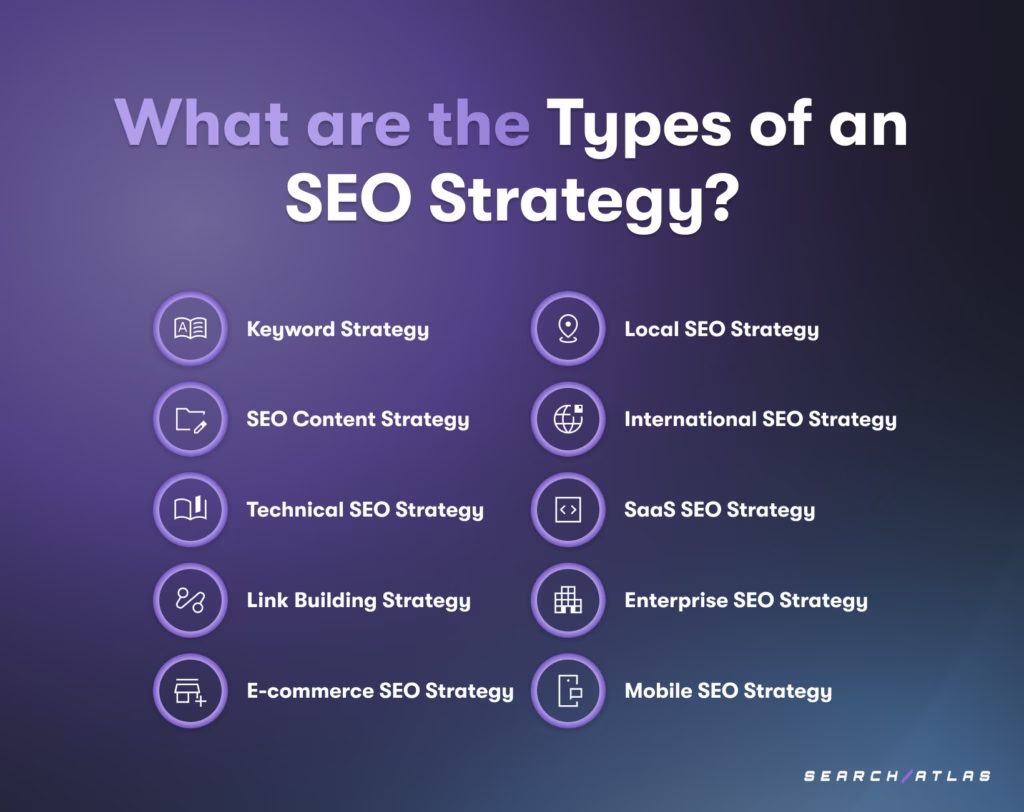
There are various types of SEO strategies that can be applied to maximize visibility and performance, depending on your target audience, industry, and website structure. The most common types of SEO strategies are listed below.
- Keyword Strategy. A keyword strategy involves identifying and targeting the most relevant and high-traffic search terms your audience uses. A keyword strategy lays the foundation for content creation, on-page optimization, and aligning with user intent to drive qualified organic traffic.
- SEO Content Strategy. An SEO content strategy focuses on planning, creating, and optimizing content to rank in search engines. An SEO content strategy makes sure that your content addresses user needs, includes targeted keywords, and follows a logical structure for maximum visibility and engagement.
- Technical SEO Strategy. A technical SEO strategy aims to improve the backend elements of your website, such as site speed, mobile responsiveness, crawlability, and indexability. A technical SEO strategy makes sure that search engines can efficiently access, understand, and rank your content.
- Link Building Strategy. A link-building strategy focuses on acquiring high-quality backlinks from reputable websites. The backlinks act as votes of confidence for your site, boosting authority and improving your rankings in search engine results.
- E-commerce SEO Strategy. An e-commerce SEO strategy is tailored to online stores, focusing on optimizing product pages, category pages, and site navigation to drive traffic and increase conversions. An e-commerce SEO strategy includes managing duplicate content, improving site structure, and using structured data for product listings.
- Local SEO Strategy. A local SEO strategy helps businesses appear in search results for location-specific queries. A local SEO strategy involves optimizing Google Business Profiles (GBPs), creating local content, managing reviews, and building local citations.
- International SEO Strategy. An international SEO strategy is designed for businesses targeting audiences in multiple countries or languages. An international SEO strategy includes setting up hreflang tags, using country-specific domains or subfolders, and creating culturally relevant content.
- SaaS SEO Strategy. A SaaS SEO strategy focuses on generating leads and traffic for software-as-a-service (SaaS) companies. A SaaS SEO strategy typically involves targeting B2B keywords, creating solution-oriented content, and optimizing for conversions through product pages and blog content.
- Enterprise SEO Strategy. An enterprise SEO strategy is built for large-scale websites with thousands of pages. An enterprise SEO strategy emphasizes scalable SEO practices, cross-team collaboration, technical infrastructure, and advanced analytics to maintain and grow search presence.
- Mobile SEO Strategy. A mobile SEO strategy makes sure that a website is fully optimized for mobile users. A mobile SEO strategy includes responsive design, fast load times, and mobile-friendly navigation, all of which contribute to better rankings and user experience on smartphones and tablets.
How to Create an Effective SEO Strategy?
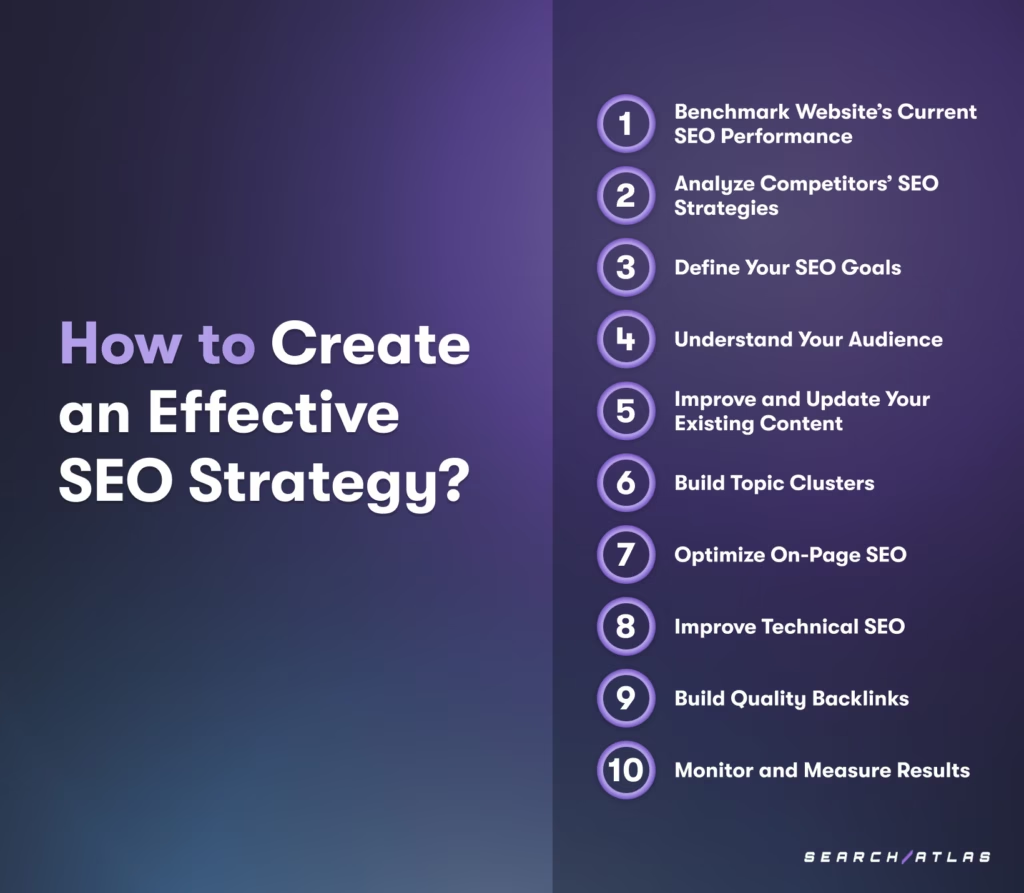
There are 10 steps to create an effective SEO strategy that helps your website rank higher, attract quality traffic, and meet your business goals. The 10 steps to create an SEO plan are given below.
1. Benchmark Your Website’s Current SEO Performance
Benchmarking your website’s current SEO performance involves conducting a comprehensive assessment of how your site currently ranks and performs in search engines. Benchmarking your website’s current SEO performance creates a quantifiable baseline against which all future SEO efforts can be measured to demonstrate progress and ROI.
Analyzing your website’s current search engine performance improves SEO effectiveness by establishing a clear starting point against which all future progress can be measured. Assessing your website’s search engine performance reveals critical issues holding back your site’s rankings, exposes content gaps and technical problems requiring immediate attention, and highlights competitive advantages you can leverage. Additionally, evaluating your website’s current SEO performance creates accountability and enables accurate measurement of SEO progress over time.
Use the Search Atlas Site Explorer Tool to benchmark your website’s current SEO performance. The Search Atlas Site Explorer Tool generates detailed SEO metrics and competitive insights when you enter a website URL into the search bar. Simply paste your website’s URL, select a country, and click “Search” to generate the Site Explorer report. The Search Atlas Site Explorer Tool identifies authority score metrics (Domain Power, Domain Authority, and Domain Rating), organic and paid traffic, organic and paid keyword rankings, backlink profiles, spam scores, and URL ratings.
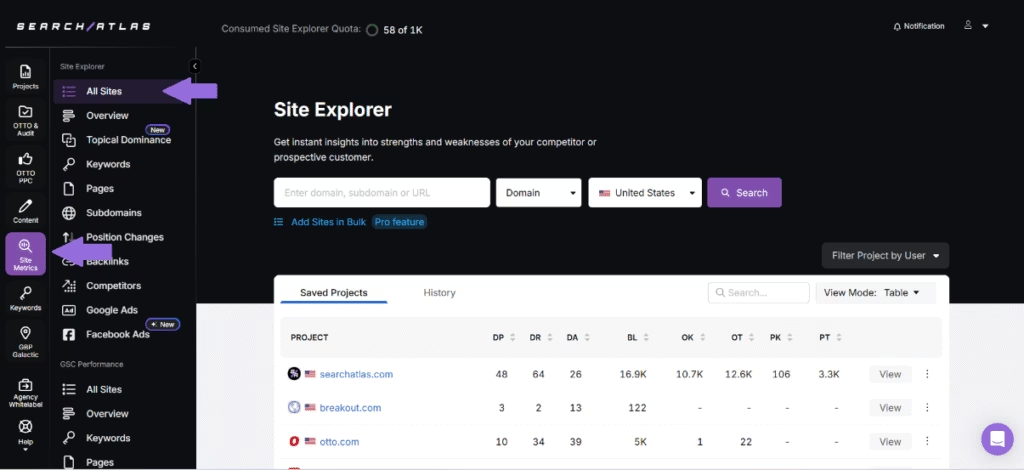
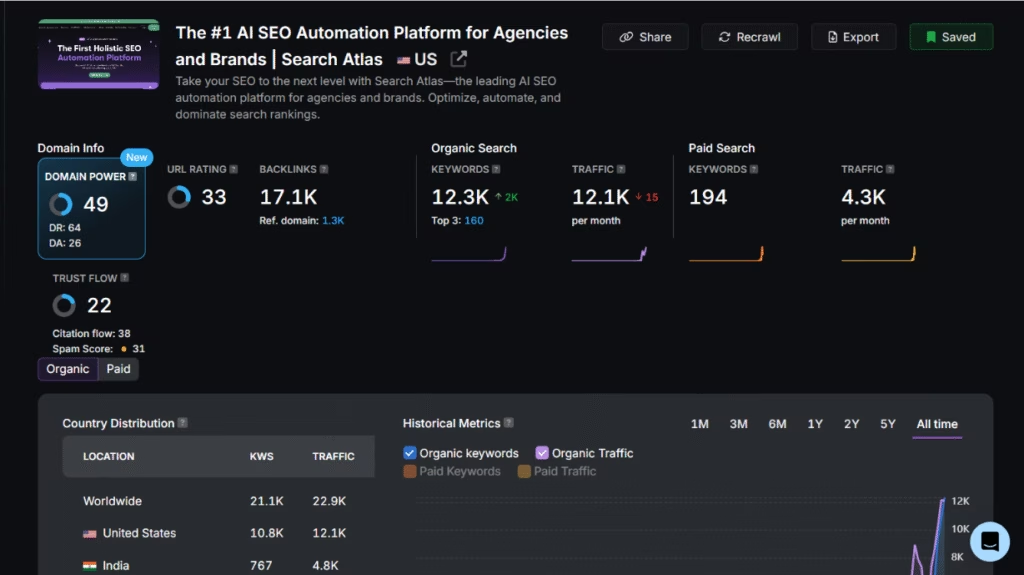
2. Analyze Competitors’ SEO Strategies
Analyzing competitors’ SEO strategies involves studying how other websites in your industry attract and rank for organic traffic. Analyzing competitors’ SEO strategies includes examining their keyword usage, backlink profiles, content structure, and technical SEO practices to identify what they are doing well and where you can outperform them.
Examining the SEO strategies of your competitors improves your own optimization efforts by revealing proven tactics that work in your specific industry and market context. Evaluating competitors’ SEO strategies helps you identify content gaps and keyword opportunities your competitors are successfully targeting but you have missed, saving valuable research time. Additionally, competitor SEO strategy analysis prevents you from reinventing the wheel by showing which strategies are already delivering results for similar businesses.
To analyze your competitors’ SEO strategies, start by using the Search Atlas Site Explorer Tool’s Competitors Tab to identify your top SEO competitors. Use the Search Atlas Keyword Gap Tool to discover keywords your competitors currently rank for but you don’t. Leverage the Search Atlas Link Gap Analysis Tool to compare your backlink profile with your competitors and identify link-building gaps and opportunities. Use the Search Atlas Site Explorer Tool’s Topical Dominance Tab to benchmark your site’s topical authority against your competitors.
The Search Atlas Site Explorer Tool’s Competitors Tab helps you identify your top online competitors and evaluate their competitive positioning based on key SEO metrics such as organic keywords and organic traffic. Simply enter your domain and target country and click “Search.” The Search Atlas Site Explorer Tool’s Competitors Tab helps you better understand where you stand in relation to other players in your niche, helping you shape more effective SEO and content strategies.
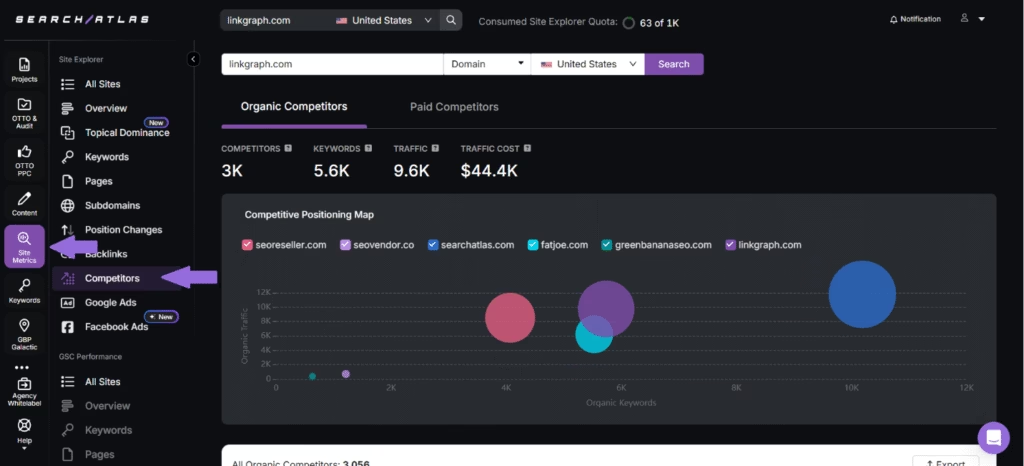
The Search Atlas Keyword Gap Tool compares the keyword performance of your website with up to six competitors to reveal high-value terms your competitors rank for but you don’t, and highlight gaps in your content strategy. The Search Atlas Keyword Gap Tool enables you to expand your keyword coverage, target new search queries, and strengthen your competitive position in search results.
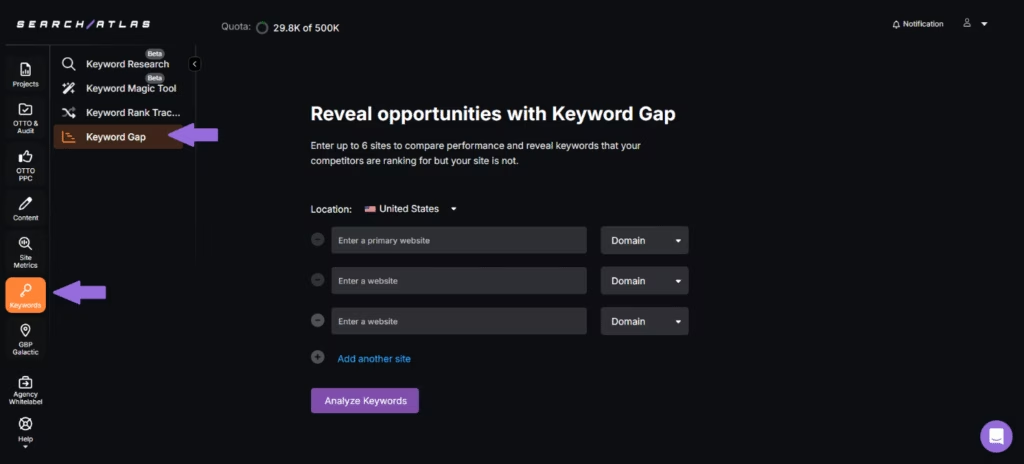
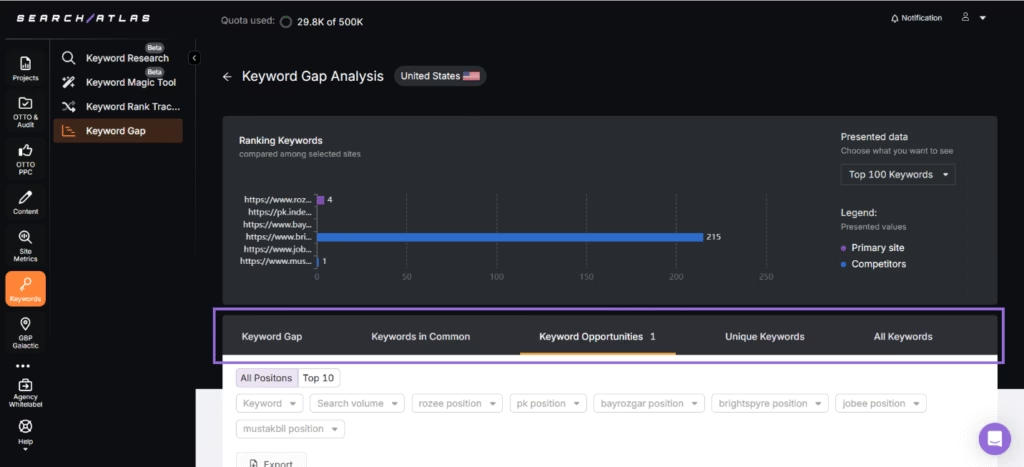
The Search Atlas Link Gap Analysis Tool helps you identify the backlink gap between your website and competitors. The Search Atlas Link Gap Analysis Tool provides you with a list of websites, their Domain Authority scores, spam scores, and the top linking page for each competitor.
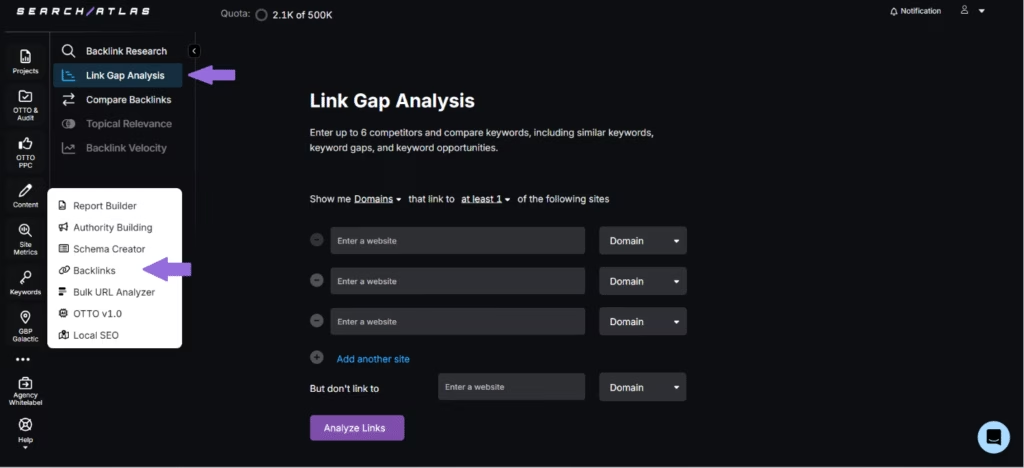
The Topical Dominance Tab within the Search Atlas Site Explorer Tool helps you compare your website’s topical authority against competitors for specific subject areas. Simply enter your domain and a competitor’s, and the Search Atlas Site Explorer Tool’s Topical Dominance Tab analyzes and scores how well each site covers various topics, highlighting strengths and gaps. The Search Atlas Site Explorer Tool’s Topical Dominance Tab pinpoints content areas where your competitor’s site is performing well but yours is underperforming to allow you to refine your strategy.
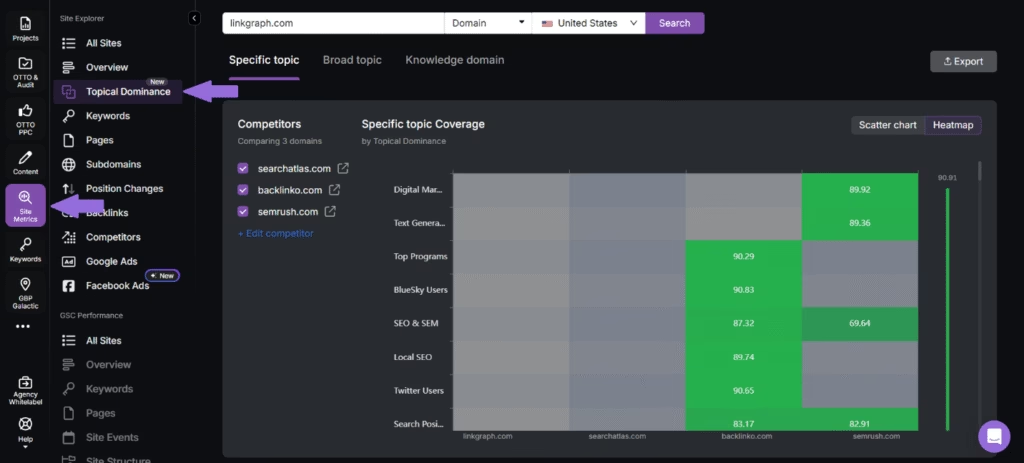
3. Define Your SEO Goals
Defining your SEO goals means setting clear, measurable objectives for what you want to achieve through your search engine optimization efforts. These SEO goals could range from increasing organic traffic, boosting keyword rankings, generating more leads, improving conversion rates, or increasing brand visibility.
Setting clear SEO goals helps improve your optimization effectiveness by giving your strategy direction and purpose. Establishing clear SEO goals helps you align your actions with specific outcomes, making sure that every optimization effort supports a larger business objective. Additionally, clarifying SEO goals makes it easier to track progress, evaluate success, and adjust your strategy based on data.
To define your SEO goals effectively, start by aligning them with your overall business objectives. For example, if your business wants to grow online sales, your SEO goal might focus on optimizing product pages or targeting high-intent keywords. Use SMART goals, Specific, Measurable, Achievable, Relevant, and Time-bound, to keep your targets realistic and actionable. Establish both short-term and long-term goals to maintain momentum and direction. Document goals formally and share them with all stakeholders to guarantee alignment. Revisit the goals quarterly to make sure they remain relevant as business priorities shift and as you gather performance data.
Defining clear SEO goals keeps your strategy on track and makes it easier to measure progress and celebrate small wins along the way. Setting proper SEO goals brings structure to your efforts and helps guarantee long-term success in a constantly evolving digital environment.
4. Understand Your Audience
Understanding your audience means knowing who your ideal visitors are, what they are searching for, how they search, and what kind of content they find valuable. Understanding your audience involves researching their demographics, preferences, pain points, and online behaviors to create content that truly meets their needs.
Gaining insight into your audience can help you improve SEO by creating more relevant and targeted content that matches their search intent. Search engines prioritize pages that provide real value to users, so aligning your content with what your audience wants increases engagement, reduces bounce rates, and improves rankings. Additionally, understanding your target audience helps you choose the right keywords, craft compelling messaging, and guide users more effectively through your website.
The tips for understanding your audience are listed below.
- Create audience personas based on data such as age, gender, location, occupation, interests, and online behavior.
- Use tools like Google Analytics, social media insights, and customer surveys to gather real user data and identify patterns.
- Analyze search intent by looking at the types of queries your audience uses, whether informational, navigational, or transactional.
- Engage with your audience directly through comments, forums, or social media to understand their questions and concerns.
- Monitor user behavior on your site to see which pages perform well and where visitors drop off.
Getting to know your target audience makes sure that your SEO efforts are about ranking higher, as well as connecting with the right people. When your content speaks directly to your target audience’s needs and interests, it naturally earns more clicks, shares, and conversions, making your SEO strategy far more impactful.
5. Improve and Update Your Existing Content
Improving and updating your existing content involves revisiting previously published pages or blog posts to improve their quality, relevance, and performance. Improving and updating your existing content can include refreshing outdated information, adding new insights, improving keyword usage, and optimizing for a better user experience and search intent.
Auditing and upgrading your existing content helps improve SEO by signaling to search engines that your site is active and current. Fresh, high-quality content tends to perform better in search rankings, increases user engagement, and can regain or boost lost traffic. Additionally, refreshing your existing content helps you make the most of your current assets without always needing to create new content from scratch.
The best practices for improving and updating your existing content are given below.
- Use tools like the Search Atlas Scholar Tool and the Search Atlas On-Page Audit Tool to audit your existing content and evaluate its relevance, structure, and depth around a targeted keyword.
- Update facts, statistics, and outdated references to make sure the content remains accurate and relevant.
- Improve readability by breaking up long paragraphs and adding headings, bullet points, and visuals.
- Leverage the Search Atlas Content Genius Tool to optimize the existing content with relevant keywords, topical terms, and links.
- Fix broken links and outdated media to maintain credibility and increase user experience.
- Improve meta titles and descriptions to boost click-through rates from search results.
- Republish or redate updated content to indicate freshness to both users and search engines.
The Search Atlas Scholar Tool grades your content against Google’s Page Quality Algorithm and information retrieval principles and provides clear, actionable insights to help you improve content quality and search performance. To review your content using the Search Atlas Scholar Tool, simply enter your target keyword, upload your content, URL, or draft, and click “Analyze Page.” The Search Atlas Scholar Tool will then assess your content from all angles and generate a data-driven score, highlighting specific areas for optimization.
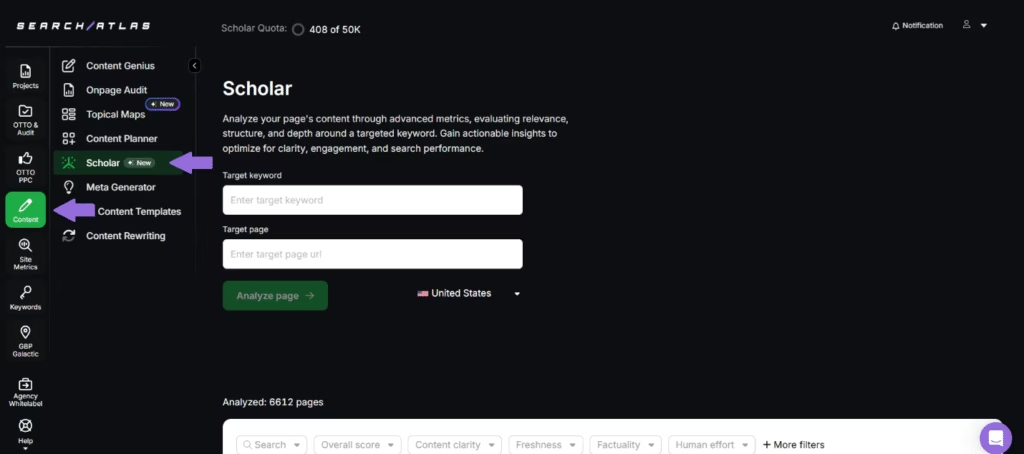
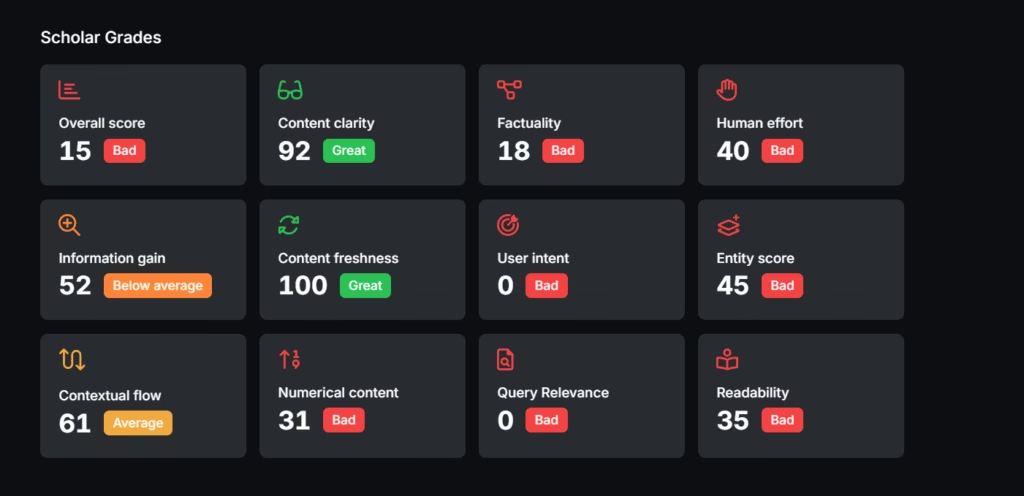
Additionally, the Search Atlas On-Page Audit Tool evaluates your content quality and SEO by analyzing key elements such as content score, word count, and readability. The Search Atlas On-Page Audit Tool allows you to compare your page against the top 10 ranking competitors for your target keyword to identify the areas where your content may fall short and need improvement. With detailed insights and guidance, the Search Atlas On-Page Audit Tool makes sure your content is relevant and engaging and aligns with what search engines prioritize to help you improve visibility, boost rankings, and better connect with your target audience.
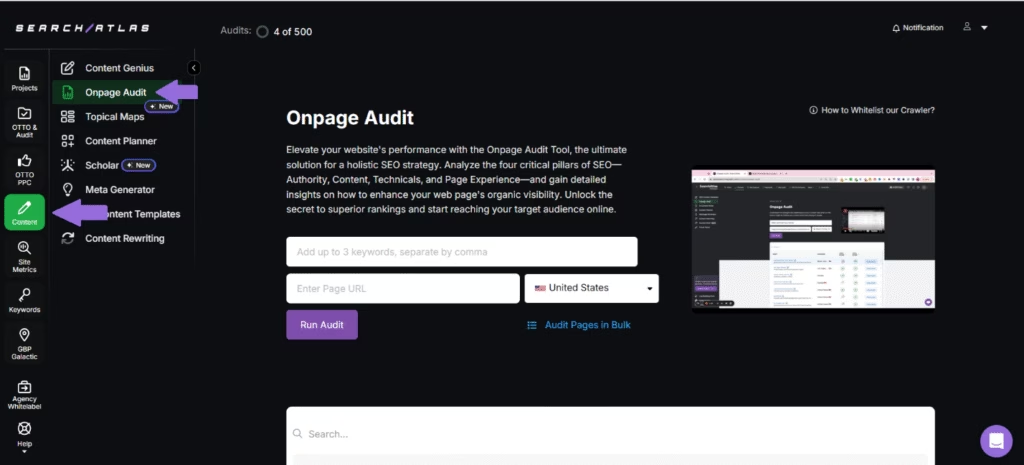
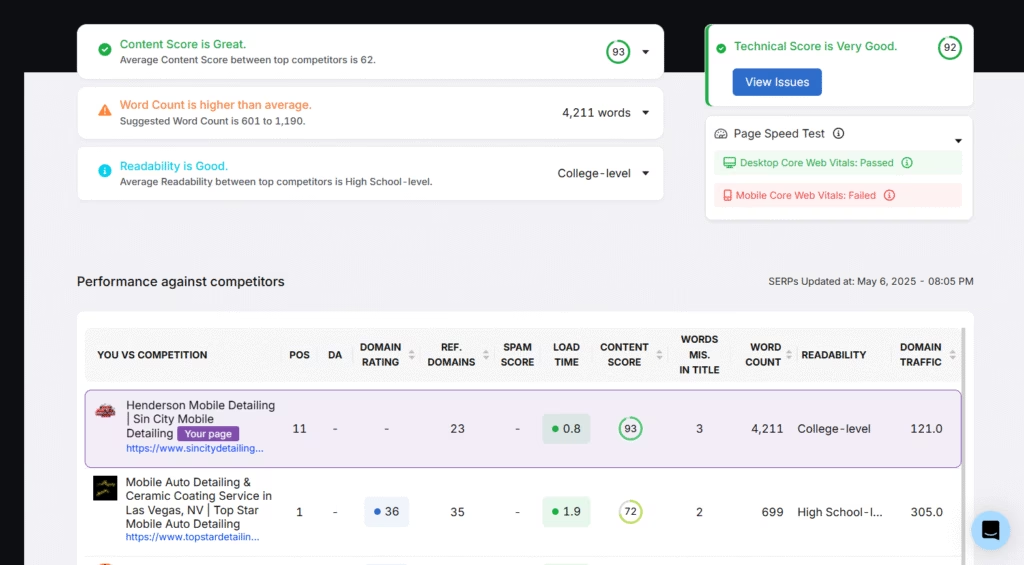
The Search Atlas Content Genius Tool is an AI-powered tool designed to simplify and improve the content creation and optimization process. The Search Atlas Content Genius Tool combines integrated keyword research, SERP analysis, and NLP-driven suggestions to help you create SEO-optimized articles effortlessly. The Search Atlas Content Genius Tool analyzes top-performing content for your target keywords and generates detailed content briefs, including suggested headings, relevant questions, topical terms, and recommended links.
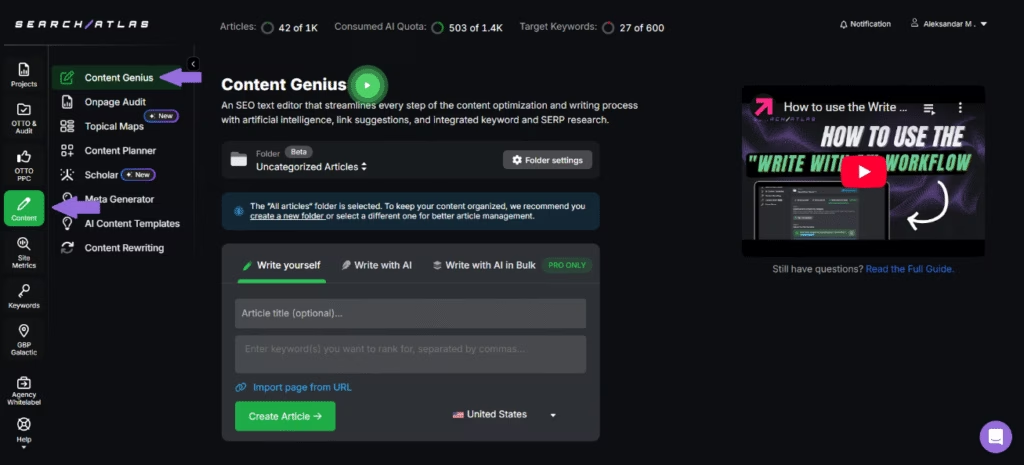
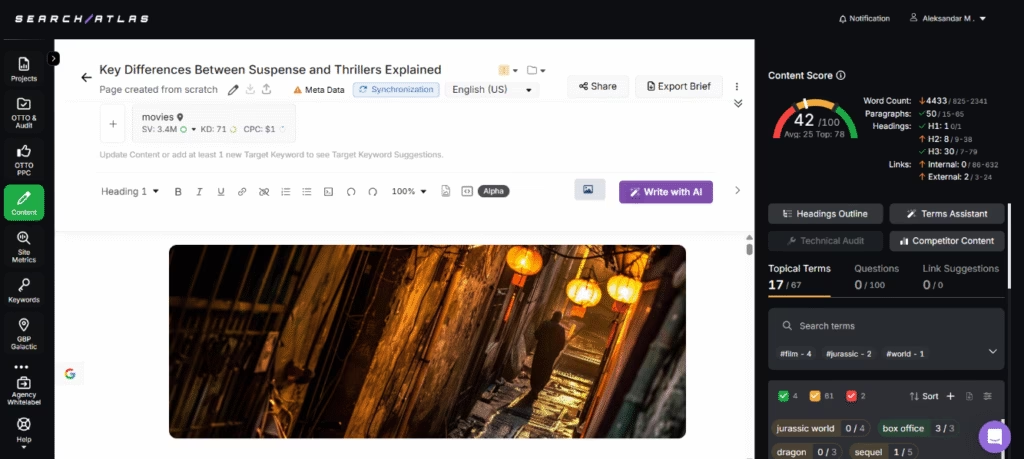
6. Build Topic Clusters
Topic clusters are a strategic content organization model that structures website content around core subjects relevant to your business. The 3 main components of topic clusters are given below.
- A pillar page that covers a main topic comprehensively.
- Cluster pages that explore specific aspects of the main topic in greater depth.
- Interlinking between the pillar and cluster pages and sometimes the cluster pages themselves creates a deliberate internal linking structure that establishes topical authority.
Building topic clusters improves SEO by helping search engines understand your site’s content hierarchy and topical relevance. Building topic clusters improves user experience by guiding visitors through related information, increasing time on site, reducing bounce rates, and boosting authority on specific subjects. Additionally, creating topic clusters shows search engines that your site is a trusted resource in your niche, which can improve rankings across the board.
To build topic clusters, identify core topics (pillar content) that are broad and align with your business goals or main services. Use the Search Atlas Keyword Research Tool to conduct keyword research and find related long-tail keywords that can serve as cluster topics. Leverage the Search Atlas Topical Maps Tool to build relevant topical maps based on your target keyword or topic. Create in-depth pillar pages that provide comprehensive information and link to related cluster posts. Develop multiple supporting articles that target specific aspects of the pillar topic.
Additionally, interlink all content within the cluster to strengthen topical authority and guide search engines through your content structure. Use consistent URL structures and naming conventions to maintain clarity and organization. Monitor performance metrics to evaluate which clusters drive the most traffic and engagement. Update and expand clusters over time to stay relevant and maintain search visibility.
The Search Atlas Keyword Research Tool can help you identify high-impact keywords that form the foundation of strong topic clusters. The Search Atlas Keyword Research Tool provides comprehensive insights into key metrics such as search volume, cost-per-click (CPC), keyword difficulty, top-ranking pages, and related keyword suggestions. Additionally, the Search Atlas Keyword Research Tool empowers you to explore keyword variations, semantically related terms, and commonly asked questions to make it easier for you to plan both pillar and cluster content.
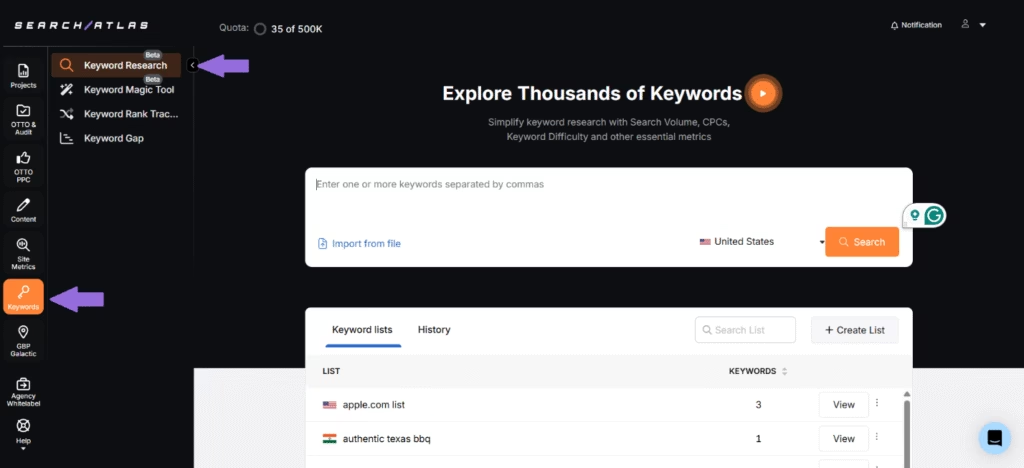
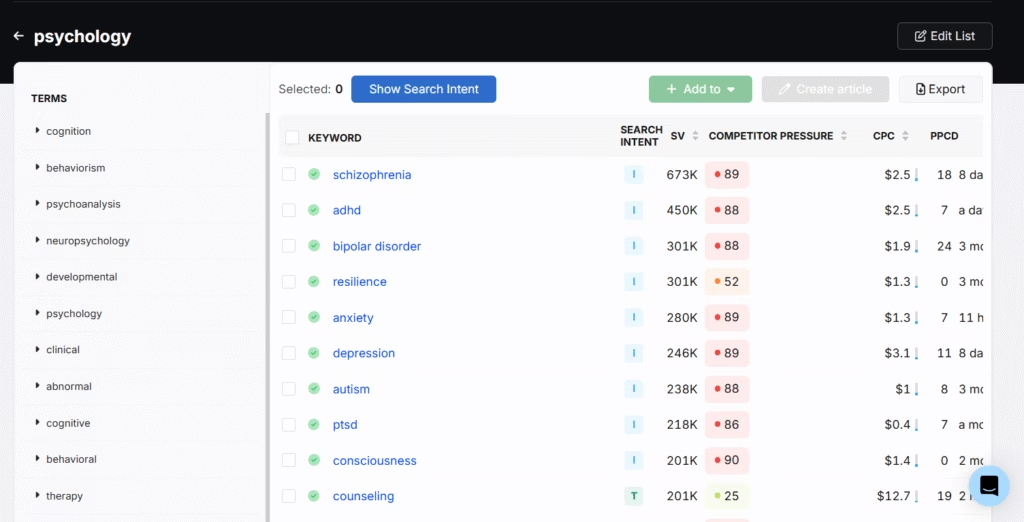
The Search Atlas Topical Maps Tool is specifically designed to help you build relevant, SEO-friendly topic clusters around your target keywords or themes. The Search Atlas Topical Maps Too allows you to define the number of clusters (or categories) you want to create, making it easy to organize your content in a structured and strategic way. The Search Atlas Topical Maps Tool helps you streamline your content planning process and lay a strong foundation for an effective topic cluster strategy that drives higher visibility and engagement.
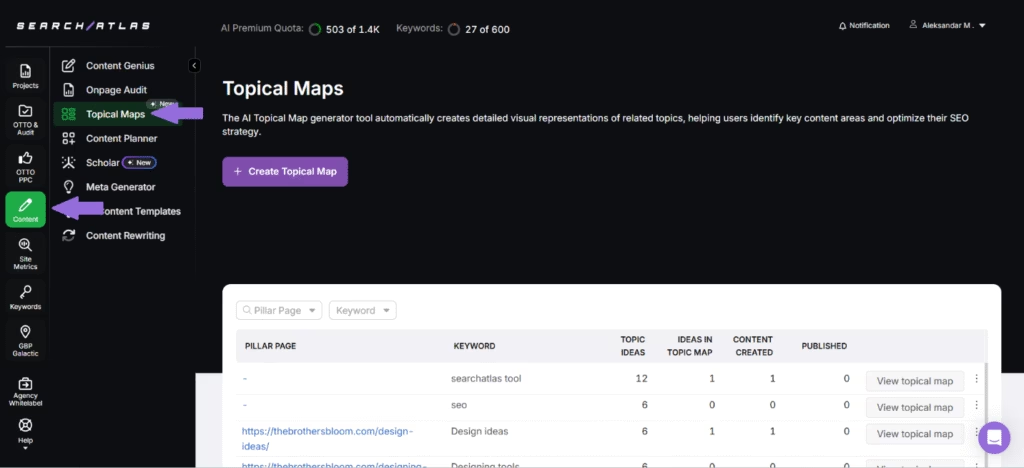
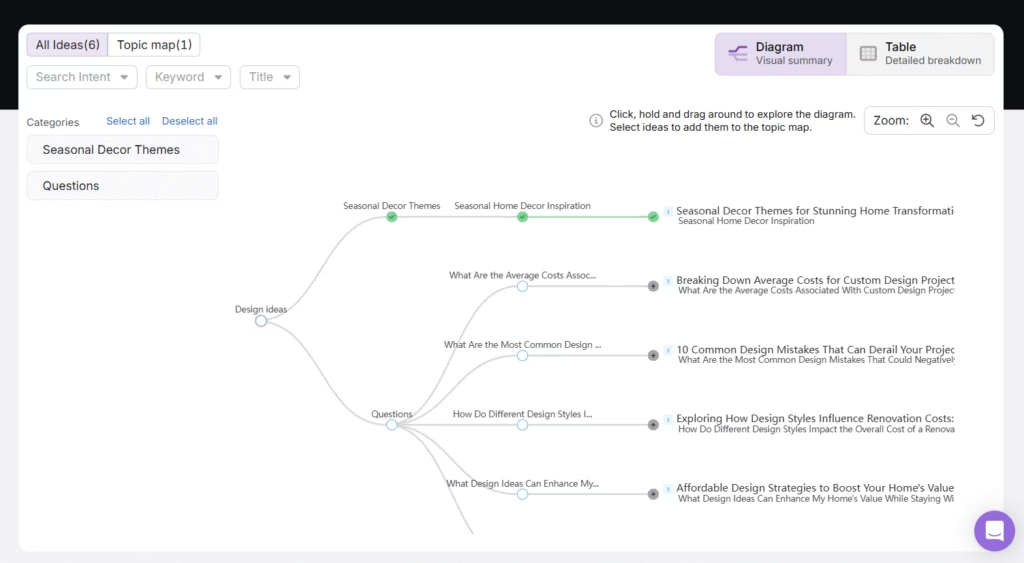
7. Optimize On-Page SEO
On-page SEO refers to the practice of optimizing individual web pages to improve their visibility in search engines and attract more relevant traffic. On-page SEO includes optimizing both the content and HTML source code of a page, such as titles, meta descriptions, headers, keywords, images, and internal links.
Optimizing on-page SEO elements directly improves search performance by providing clear signals to search engines about your page’s content and relevance to specific queries. Well-executed on-page SEO optimization helps search engines understand exactly what your content is about, increasing the likelihood that your page will be shown to users searching for relevant information. Additionally, effective on-page SEO optimization improves user experience, increases click-through rates, and boosts the chances of your pages appearing in top search results.
The best practices for optimizing on-page SEO are mentioned below.
- Include target keywords in key areas like the title tag, meta description, URL, headers (H1, H2s), and throughout the content.
- Write compelling meta titles and descriptions to increase click-through rates from search engine results pages.
- Use clear and descriptive header tags (H1, H2, H3) to organize your content and improve readability.
- Make sure your content is original, high-quality, and satisfies search intent for the target keyword.
- Optimize images with descriptive file names and alt text to improve accessibility and image search visibility.
- Use internal linking to connect related content and distribute link equity across your site.
- Improve page load speed and mobile-friendliness to improve user experience and reduce bounce rates.
- Utilize schema markup to help search engines better understand your content and improve rich results.
- Use tools like the Search Atlas On-Page Audit Tool to automate the on-page SEO optimization process and identify specific on-page issues.
The Search Atlas On-Page Audit Tool uses powerful analytical data to provide detailed feedback on your content’s performance based on targeted keywords. The Search Atlas On-Page Audit Tool assesses your page’s structure to look into optimization opportunities to improve its visibility, relevance, and user experience. Additionally, the Search Atlas On-Page Audit Tool helps you easily compare your content score, word count, and readability against top-ranking content to help you make informed improvements to boost your search visibility.

8. Improve Technical SEO
Technical SEO refers to optimizing the backend structure and foundation of your website to help search engines crawl, index, and understand your content more effectively. Technical SEO makes sure that your site meets all the technical requirements of modern search engines, which directly affects your rankings and organic visibility.
Improving technical SEO significantly improves overall search performance by removing barriers that might prevent search engines from properly understanding and ranking your content. Improving technical SEO often leads to a better user experience through faster page loading, proper mobile rendering, and intuitive site navigation. Technical SEO improvements reduce bounce rates and increase engagement metrics, which indirectly benefit search rankings as signals of content quality and relevance.
To improve technical SEO, make sure your website is mobile-friendly using responsive design to provide a seamless experience across all devices. Improve site speed by compressing images, leveraging browser caching, and minimizing code (HTML, CSS, JavaScript). Use HTTPS to secure your website and build trust with users and search engines. Monitor your site using the Search Atlas Site Auditor Tool to identify issues related to crawlability and indexability and address them promptly.
Additionally, create and submit an XML sitemap to help search engines discover and index your pages more efficiently. Implement a robots.txt file to guide search engine crawlers on which pages to access or ignore. Avoid duplicate content issues by using canonical tags and proper URL structures. Check for broken links and redirects to maintain a clean and user-friendly site architecture.
The Search Atlas Site Auditor Tool provides a detailed overview of your website’s technical performance by identifying issues related to crawlability, indexability, and site structure. Simply enter your domain, set the maximum number of pages to crawl, configure the crawl frequency, and click “Start Audit.” The Search Atlas Site Auditor Tool then scans your pages and highlights the most critical SEO issues using customizable Page Explorer reports.
The Search Atlas Site Auditor Tool allows you to combine crawl data with metrics from Google Search Console and Google Analytics to help you quickly identify problems on your most important landing pages. This type of targeted, data-driven analysis makes sure your website’s technical foundation is solid and supports better search visibility and long-term SEO success.

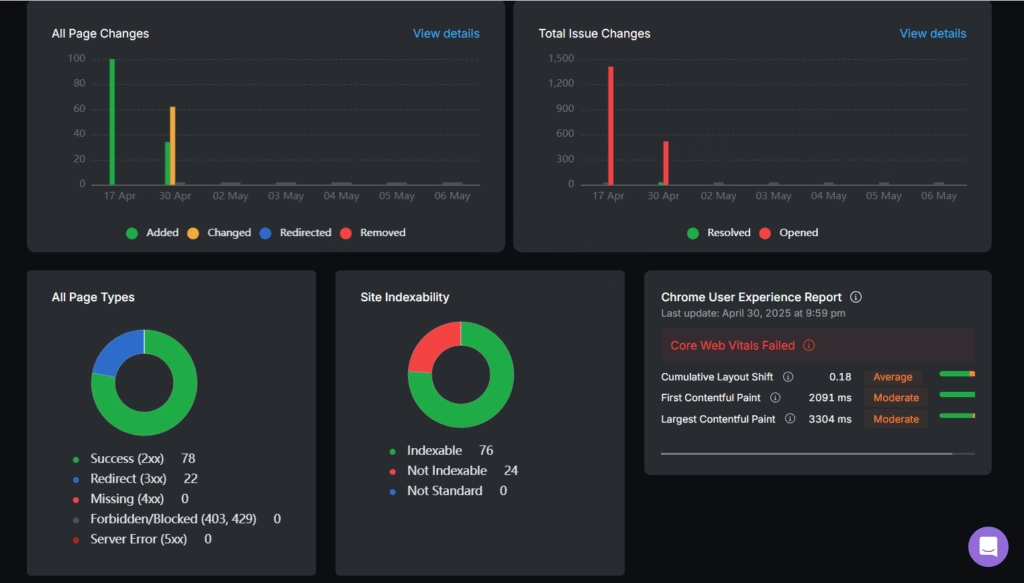
9. Build Quality Backlinks
Building quality backlinks is the strategic process of earning hyperlinks from other websites to your own. These external links act as votes of confidence or endorsements from one site to another, signaling to search engines that others vouch for your content’s value and credibility.
Building quality backlinks improves SEO by boosting your site’s domain authority, helping search engines discover your pages faster, and increasing your chances of ranking higher in search engine results. Building quality backlinks drives referral traffic from relevant audiences already interested in your industry or topic, bringing engaged visitors who are more likely to convert. Additionally, acquiring high-quality backlinks improves brand visibility and credibility by associating your site with established authorities in your field.
The best practices for building quality backlinks are listed below.
- Create high-value, shareable content such as original research, in-depth guides, infographics, or thought leadership articles.
- Use guest posting on trusted websites in different markets to gain exposure and high-quality backlinks. Use professional platforms like Link Laboratory to guarantee the highest quality of links without the struggle of manually finding websites.
- Leverage broken link building by identifying broken links on other sites and suggesting your content as a replacement.
- Get listed in reputable online directories and industry-specific listings.
- Engage in digital PR with tools like Signal Genesys and collaborate with local media outlets for authoritative mentions and links.
- Engage in strategic partnerships and collaborations with influencers or complementary businesses.
- Promote your content on social media to increase visibility and the likelihood of earning natural backlinks.
- Use tools like the Search Atlas Backlink Research Tool to identify linking opportunities.
The Search Atlas Backlink Research Tool is a powerful resource for identifying valuable link-building opportunities. The Search Atlas Backlink Research Tool provides comprehensive domain and page-level insights for any website, URL, or subdomain, allowing you to identify where and how your competitors are earning their backlinks. With detailed backlink metrics, historical link trends, and anchor text analysis, the Search Atlas Backlink Research Tool helps you discover high-quality linking opportunities, track competitor strategies, and improve your website’s authority in global markets.
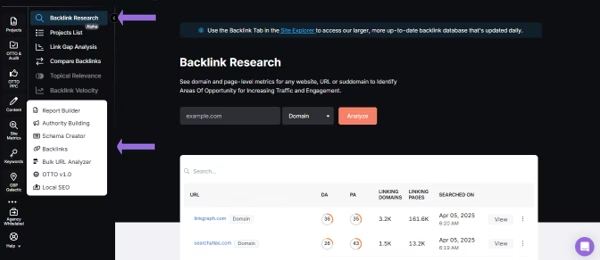
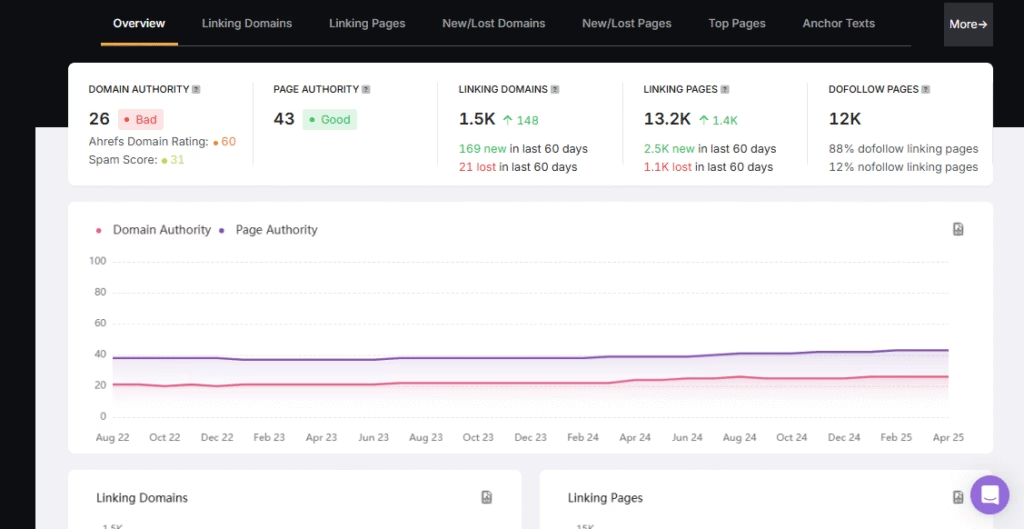
10. Monitor and Measure Results
Monitoring and measuring results is the process of tracking the performance of your SEO strategy over time using data and analytics tools. Monitoring and measuring results make sure that all your optimization efforts are producing the desired outcomes and allow you to identify areas for improvement.
Tracking and measuring SEO metrics help improve SEO by revealing what is working, what is not, and where adjustments are needed. Monitoring and analyzing results enables you to identify and address issues before they become significant problems. Regularly tracking and evaluating results catches ranking drops, traffic decreases, or technical issues early, allowing for prompt intervention that minimizes negative impact. Additionally, consistently tracking and measuring results helps you understand how search engine algorithm updates affect your site specifically, providing crucial context for adaptation and resilience.
To monitor and measure results, set up and regularly review Google Analytics and Google Search Console to monitor organic traffic, user behavior, and search performance. Track keyword rankings using tools like the Search Atlas Keyword Rank Tracker Tool to assess your visibility in search results. Monitor backlinks and domain authority to understand the strength and credibility of your website. Analyze click-through rates, bounce rates, and average session duration to evaluate content performance and user engagement.
Additionally, measure conversion rates from organic traffic to determine how well your SEO efforts are driving business goals. Use custom dashboards and reporting tools for regular performance updates and team collaboration.
The Search Atlas Keyword Rank Tracker Tool automatically checks the rankings of your target keywords at your chosen frequency and provides insights into key metrics, including current position, search volume, SERP features, and ranking trends over time, to help you evaluate your keyword performance and adjust your SEO strategy accordingly. Additionally, the Search Atlas Keyword Rank Tracker Tool provides a detailed overview of the number of keywords your competitors have in the top 10 and the rate of their search visibility to help you identify content gaps and possible ranking opportunities.
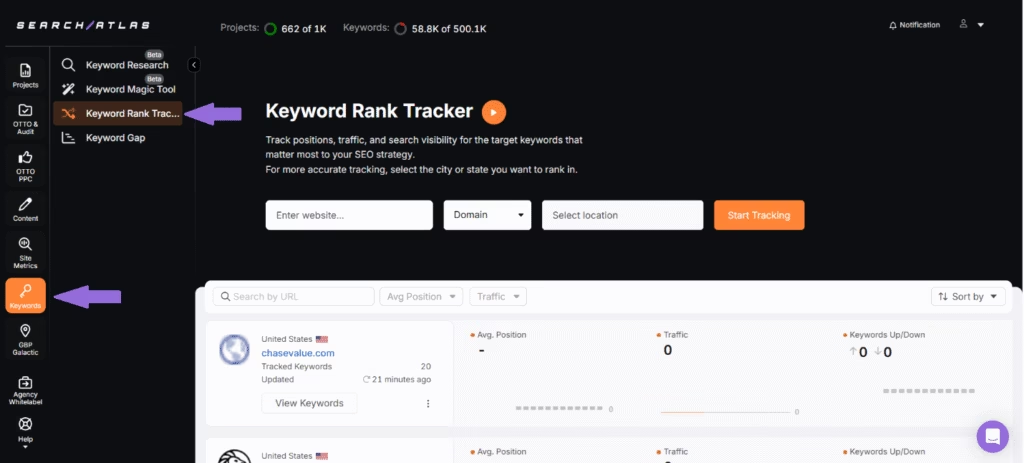

How Can AI Be Used to Enhance Your SEO Strategy?
AI can be used to enhance your SEO strategy by automating time-consuming tasks, uncovering insights, and optimizing content with greater precision. With the ability to process and analyze massive amounts of data in real time, AI helps marketers make informed decisions that directly impact search visibility and rankings.
AI tools can assist in keyword research by identifying high-potential keywords and exploring related search terms based on user behavior and search trends. AI-powered tools can analyze top-ranking content to suggest optimal content structures, headings, and NLP terms that align with search intent, resulting in content that is more likely to rank well and resonate with your target audience. Additionally, artificial intelligence tools improve technical SEO by automatically detecting and fixing site issues such as crawl errors, broken links, and slow page speeds. These technical improvements contribute to a better user experience and improved search engine rankings.
AI can be used for competitor analysis by identifying backlink sources, keyword opportunities, and content gaps. This competitor analysis through AI tools allows you to build a more targeted and competitive SEO strategy based on real-time market data. Some AI-driven solutions even offer predictive analytics to help forecast trends and performance, allowing your SEO efforts to stay ahead of the curve.
In essence, adopting an AI SEO strategy saves time and gives you a competitive edge. An AI SEO strategy empowers you to make smarter, faster, and more strategic decisions that drive sustainable growth in search visibility and organic traffic.
What Tools to Use to Create an Seo Strategy?
There are several tools you can use to create an SEO strategy and optimize your website for better visibility, performance, and search engine rankings. Free tools like Google Search Console allow you to track your website’s indexing status, monitor search performance, identify technical errors, and optimize your visibility in search results. Google Analytics offers in-depth traffic data and user behavior analysis, helping you align your SEO goals with actual user activity. Google Keyword Planner helps you discover new keyword opportunities and assess their competitiveness. Meanwhile, Google Trends allows you to explore the popularity of search terms over time, helping you identify seasonal trends and capitalize on rising topics.
The Search Atlas SEO Software Platform, on the other hand, offers a powerful all-in-one solution for more advanced and scalable SEO strategies. The Search Atlas Site Explorer Tool gives a complete overview of your domain’s SEO metrics, including authority scores like Domain Rating and Trust Flow, organic and paid keyword rankings, backlink profiles, spam scores, and traffic estimates. The Search Atlas Link Gap Analysis Tool helps you identify the backlink gap between your website and competitors. The Search Atlas Keyword Gap Tool shows high-value terms your competitors rank for but you don’t and highlights gaps in your content strategy.
The Search Atlas Scholar Tool grades your content across multiple dimensions to help you evaluate and guarantee your content’s relevance, structure, and depth around targeted keywords. The Search Atlas On-Page Audit Tool zooms in on individual pages, analyzing internal linking, heading structure, keyword placement, and metadata to fine-tune on-page SEO. The Search Atlas Content Genius Tool helps you optimize the existing content with relevant keywords, topical terms, and links.
The Search Atlas Keyword Research Tool helps you discover valuable keywords by offering insights into search volume, competition level, and keyword relevance to optimize your content strategy effectively. The Search Atlas Topical Maps Tool assists you in building comprehensive content clusters by visually organizing related keywords and topics, guaranteeing better topical authority and structured SEO planning.
The Search Atlas Site Auditor Tool performs a comprehensive technical health check of your website, highlighting critical issues like crawl errors, missing metadata, and performance bottlenecks to help optimize your site for better search visibility. The Search Atlas Backlink Research Tool evaluates your backlink profile, discovers toxic links, and identifies new link-building opportunities. The Search Atlas Rank Tracker Tool monitors your keyword positions across multiple search engines and locations, giving you actionable insights to adjust your strategy over time.
The Search Atlas OTTO SEO Tool automates most of the SEO strategy creation process by analyzing your site, offering recommendations, and even applying changes directly to save time and guarantee continuous optimization without manual intervention.
Using a combination of free tools like Google’s SEO suite for foundational insights and Search Atlas SEO tools for in-depth analysis, keyword targeting, competitor tracking, and content optimization can empower you to create a well-rounded and effective SEO strategy. Each tool plays a critical role in different stages of the SEO strategy creation process, from planning and execution to monitoring and refinement.
What is the Difference Between SEO Strategy and SEO Content Strategy?
The difference between SEO strategy and SEO content strategy is that an SEO strategy is an overall plan to improve a website’s visibility in search engines, while an SEO content strategy focuses specifically on creating and optimizing content to support that broader SEO plan.
An SEO strategy is a comprehensive roadmap that outlines how to improve a website’s rankings on search engines like Google. An SEO strategy covers both on-page and off-page SEO elements, technical SEO, keyword targeting, link-building, site structure, and user experience. The goal of an SEO strategy is to increase organic traffic, boost keyword rankings, and drive more conversions from search engine users.
In contrast, an SEO content strategy zeroes in on the planning, creation, and optimization of content that targets specific keywords and user intent. An SEO content strategy helps make sure that the content published on a website provides value to readers and is structured in a way that search engines can understand and rank effectively. An SEO content marketing strategy involves keyword research, topic planning, on-page optimization, and performance tracking. The goal of an SEO content strategy is to produce content that ranks well, engages users, and supports the broader SEO efforts by filling content gaps and addressing search queries across the buyer’s journey.
What is the Relation Between SEO Strategy and SEO Best Practices?
The relation between an SEO strategy and SEO best practices is that best practices form the foundation upon which a successful SEO strategy is built.
An SEO strategy is a structured, long-term plan designed to improve a website’s visibility and performance on search engines. An SEO strategy involves analyzing your market, researching keywords, optimizing your website architecture, creating and promoting content, building backlinks, and monitoring performance.
SEO best practices, on the other hand, are the standard techniques and guidelines recommended by search engines to make sure your website is optimized effectively. Best practices in SEO include optimizing meta tags, using clean URLs, verifying mobile-friendliness, improving page speed, writing high-quality content, using proper header tags, and maintaining a logical site structure. SEO best practices are the essential actions you take within your broader SEO strategy to guarantee search engine compliance and improved rankings.
What is the Relation Between SEO Strategy and SEO Campaign?
The relation between an SEO strategy and an SEO campaign is that an SEO strategy provides the long-term plan and direction, while an SEO campaign executes specific actions within that plan to achieve targeted SEO goals.
An SEO strategy is a comprehensive framework that outlines how a website will improve its visibility in search engine results. An SEO strategy is usually ongoing and evolves over time based on data, market trends, and search engine algorithm changes.
An SEO campaign, on the other hand, is a focused, time-bound effort within that broader strategy. SEO campaigns are typically designed around specific goals, such as increasing rankings for a new product page, building backlinks to a set of articles, or driving traffic during a promotional period. An SEO campaign may involve a series of coordinated tasks like publishing blog content, conducting outreach, optimizing landing pages, or running audits.


